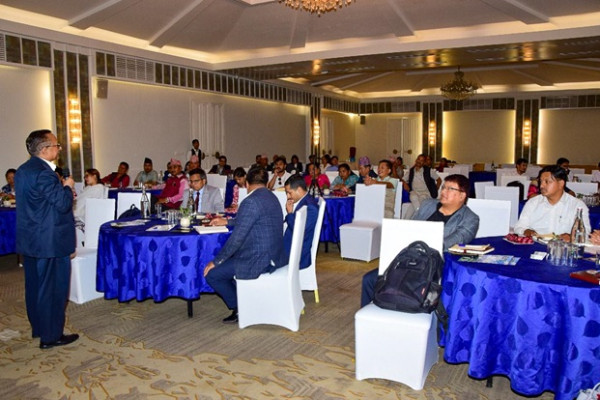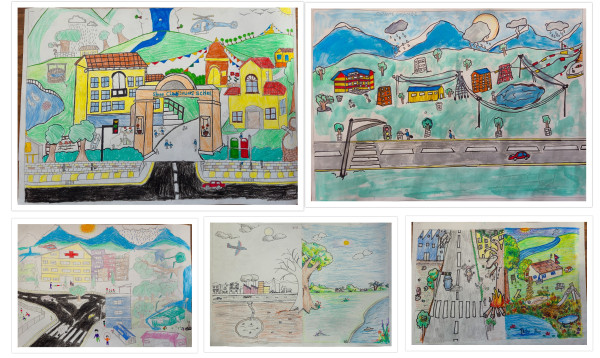
Urban EbA
Urban Ecosystem-based Adaptation (EbA) for Climate-resilient Development in the Kathmandu Valley
|
Project Fund: |
Global Environment Facility (GEF-LDC Fund) |
|
GEF Agency: |
United Nations Environment Programme (UNEP) |
|
Executing Entity: |
Kathmandu Valley Development Authority (KVDA) |
|
Technical Assistance: |
UN-Habitat Nepal |
|
Purpose: |
To provide technical support in delivery of specific outputs of the Urban EbA project. |
|
Duration: |
July 2024 - December 2025 |
1. Context
Nepal has been undergoing rapid and unplanned urbanization at the cost of the natural environment; impacting ecosystems integrity and their services, including water, clean air, temperature regulation, and food security. Unplanned and haphazard urbanization lacks risk-sensitive and pro-poor urban planning, resulting in new exposure to weather and climate-induced hazards (for people and infrastructure). For example, the National Adaptation Plan (NAP), 2021-2050 identifies that the major climate-induced disasters in the Kathmandu Valley are landslides, floods, and droughts, and the number of people and units of infrastructures affected by landslides and floods has increased significantly over the last four decades. Increased incidences of flooding and landslides induced by rainfall intensity; recurring dry spells and reduced water availability actuated by the rise of temperature have been the new normal in the Kathmandu Valley. Additionally, Kathmandu Valley is experiencing an urban heat island (UHI) effect, and it has been a growing concern for city planners as it impacts human comfort, productivity, urban economy, and ecology.
Hence, there is a need for durable solutions to cope with and adapt to climate change impacts in the urban context of Kathmandu Valley. Ecosystem-based Adaptation (EbA) is evolving as one of the impactful adaptation strategies for climate risk resilience building in Nepal. EbA measures can help ecosystems recover, sustain, and thrive thereby helping the people depending on their services to be resilient in the face of rising risks of climate change. The climate policies of the Government of Nepal espouse the EbA as an approach to fight climate change. However, the EbA in the Kathmandu urban setting is a new phenomenon that lacks the adequate scale of evidence-based consisting of new EbA knowledge, and good practices instrumental to formulating or refreshing urban planning strategies, frameworks, guidelines, and programming in the backdrop of rising impacts of climate change in Kathmandu valley. Further, institutional capacity barriers, including limited technical expertise, knowledge, and awareness of urban EbA among all tiers of government, private sector, and communities, are slowing the adoption of the EbA approach in the valley.
2. Project Background
The project “Urban Ecosystem-based Adaptation for Climate-resilient Development in the Kathmandu Valley, Nepal” (Urban EbA) was approved by the Global Environment Facility (GEF) in 2019. The project is planned to be implemented targeting five municipalities, namely Kathmandu and Lalitpur Metropolitan Cities, Tokha, Madhyapur Thimi and Budhanilkantha Municipalities in Kathmandu Valley. The project is executed by the Kathmandu Valley Development Authority (KVDA) with the oversight of the United Nations Environment Programme (UNEP).
The overarching objective of this project is to build the resilience of the local communities in Kathmandu Valley amidst increased impacts of climate change, such as flooding, landslides, erosion, heat and drought. The project interventions aim to mainstream EbA into planning frameworks, budgeting and implementation mechanisms of the KVDA and five target municipalities, as a demonstration to decrease the climate-induced impacts, particularly urban flood, pollution, drought, and heat. Project interventions directly benefit 82,400 people in the selected wards of the target five municipalities, where EbA interventions will be demonstrated, while the entire municipal population will be the indirect beneficiaries of the project, through institutionalization and mainstreaming of the EbA in the municipal and KVDA’s annual planning process.
Moreover, the project adopts a demonstration approach as a proof of concept to i) enhance groundwater recharge; ii) improve soil stability; iii) check urban flooding surge; iv) reduce urban heat effect, and v) build the resilience capacity of urban households. At the same time, the entire Kathmandu population will benefit indirectly through institutionalization and mainstreaming of the EbA in the municipalities and KVDA’s decision-making and annual planning process.
3. UN-Habitat’s Technical Assistance
KVDA and UNEP have sought UN-Habitat Nepal to provide technical assistance to deliver three outputs that will provide catalytic support to expedite implementation of the Urban EbA project. The project steered by the Secretary of the Ministry of Urban Development, seeks to upscale the learnings of the project for wider replication across the municipalities within and beyond Kathmandu valley.
The project builds on the national level capacity of UN-Habitat in urban development and climate change sector and further at the regional level, UN-Habitat’s extensive engagement on urban EbA in the Asia Pacific region on capacity building and implementing the Urban EbA projects.
In this regard, UN-Habitat is collaborating with UNEP and KVDA to provide technical support to deliver three specific outputs:
- Training Materials to build the capacity of Executing agencies and Partners
- Conduct CRVA and Prepare Technical Guidelines on Urban EbA interventions
- Policy Review for EbA mainstreaming and entry points at KVDA and the local levels
4. Key Activities
- Review gender-disaggregated climate risk and vulnerability data, international guidelines and local as well as international best practices and lessons learned from EbA projects in Nepal on urban EbA to select locally appropriate EbA interventions for the Kathmandu Valley.
- Prioritise EbA interventions based on local needs, preferences of women as well as men and cost-effectiveness.
- Develop technical guides for EbA interventions, including a framework for assessing cost-effectiveness of EbA interventions.
- Review existing policies, strategic plans, by-laws and development budgets to identify entry points for urban EBA.
- Develop recommendations for the inclusion of urban EbA considerations into policy and regulatory instruments including gender-related benefits and implications.
- Develop policy briefs for national-level policymakers in the MoUD, Ministry of Forest and Environment and the National Planning Commission for recommended policy revisions to support the national upscaling of urban EBA interventions.
- Develop training materials for the planning, design, implementation and maintenance of urban EbA in the Kathmandu Valley.
- Support to train KVDA, local government staff, community and local leaders in the Kathmandu Valley on planning, implementing and maintaining EbA interventions.
- Conduct site specific Climate Risk Vulnerability Assessment (CRVA) that considers the nexus of “urban growth, environmental degradation and climate change” in the Kathmandu Valley to establish linkages among these processes and ensure the selection of locally appropriate EbA interventions.





